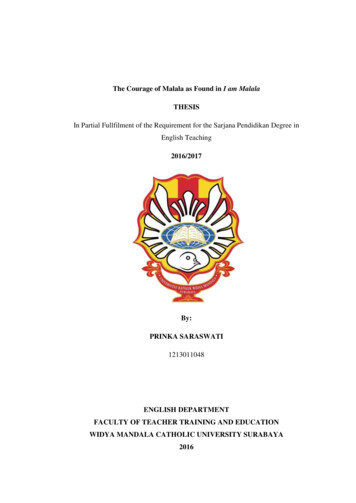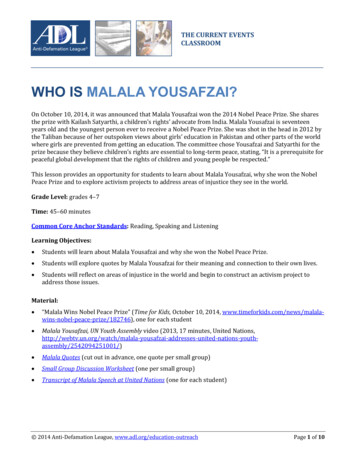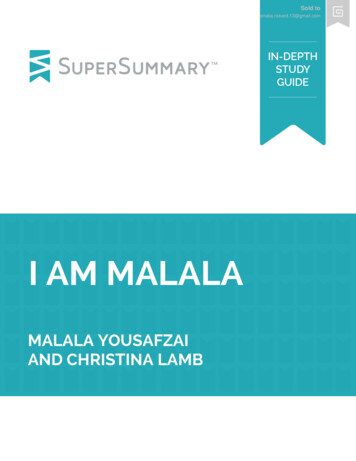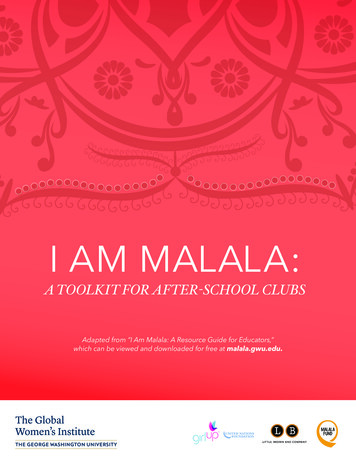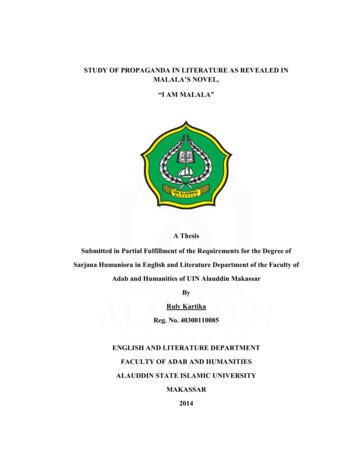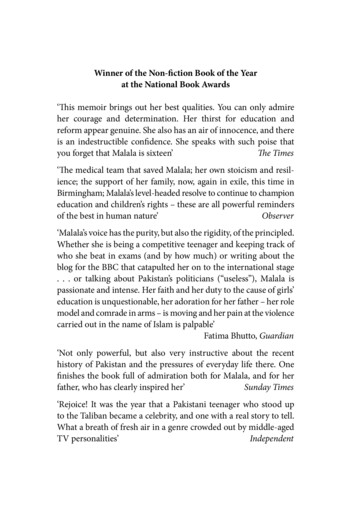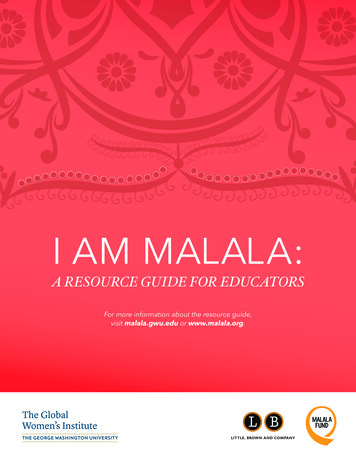
Transcription
I AM MALALA:A RESOURCE GUIDE FOR EDUCATORSFor more information about the resource guide,visit malala.gwu.edu or www.malala.org.
A PREFACE FROM MALALA’S FATHERIt is the elder generation’s duty to teach children the universal humanvalues of truth, fairness, justice and equality. For this purpose, we havetwo institutions: families and schools. Education, whether at homeor in the classroom, has the power to promote acceptance of others’views and to challenge biases and bigotry.In patriarchal societies, women are expected to be obedient. Agood girl should be quiet, humble and submissive. She is told not toquestion her elders, even if she feels that they are wrong or unjust.As a father, I did not silence Malala’s voice. I encouraged her to askquestions and to demand answers. As a teacher, I also impartedthese values to the students at my school. I taught my female students to unlearn the lesson ofobedience. I taught the boys to unlearn the lesson of so-called pseudo-honor.It is similarly the obligation of schools and universities to instill the principles of love, respect,dignity and universal humanism in their students. Girls and boys alike must learn to think critically,to stand up for what they believe is right and build an effective and healthy society. And theselessons are taught at schools through curriculum. Curricula teach young people how to beconfident individuals and responsible citizens.I Am Malala is a story about a young girl’s campaign for human rights, especially a woman’s right toeducation. The power of this story is that it is true. Truth, justice, forgiveness, and equality—these arethe universal human values, and they are the lessons instilled in Malala’s book. I am, therefore, verypleased that the Malala Fund and the George Washington University have partnered to developthis resource guide to accompany I Am Malala.The resource guide for educators will elevate Malala’s story from a news story to an inspiration forcoming generations. It tells how a country’s power and politics can endanger its own citizens. It tellshow a few people can misinterpret and misuse peaceful religions to distort their true message. Ittells how women and children suffer due to conflicts. And it tells why millions of children are outof school.People ask me, what is special about my parenting, which has made Malala so bold and socourageous and so vocal and so poised? I tell them, “Don’t ask me what I did. Ask me what I did notdo.” I did not clip Malala’s wings. Now Malala’s story will be shared in classrooms around the world.I hope that my daughter’s message will resonate with many future generations of our children andyoung people, and that they, too, will feel empowered to raise their voices and spread their wings.Ziauddin Yousafzai
To expand the reach of Malala’s memoir—I am Malala: The Girl Who Stood Up forEducation and Was Shot by the Taliban—and spread Malala’s message to young peopleand activists, the Global Women’s Institute of the George Washington University, incollaboration with the Malala Fund, developed a resource guide for high school andcollege students around the world. Building on the content of Malala’s memoir, theresource guide supports global efforts to mobilize women and men to address women’sand girls’ rights to an education.Malala’s memoir opens the door to some of the greatest challenges of our modern world.It is about politics, education, culture, religion and violence against women and girls. Itis a moment in the life of a young girl and in the history of a country. To do these broadthemes justice, faculty from a wide range of disciplines contributed to the developmentof the resource guide.The resource guide challenges students to think deeply, share their experiences, andengage with their communities. Each theme begins with learning objectives and anarrative, intended to start the conversation and help plan lessons. The theme thenincludes individual exercises, group activities, and resources to assist students andinstructors in deepening their knowledge of a topic.THE EIGHT THEMES ARE:1. Memoir as Literature and History.32. Education: A Human Right for Girls. 103. Cultural Politics, Gender and History inMalala Yousafzai’s I am Malala. 184. Religion and Religious Extremism. 255. Malala and Violence against Women and Girls. 326. Malala Leadership Essay. 407. Malala and the Media. 498. Global Feminisms: Speaking andActing about Women and Girls. 56
REFLECTIONS FROM A PAKISTANI SCHOLARI Am Malala: A Resource Guide for Educators is a unique endeavor to enlighten students and academics,providing a well-deserved space to the emerging struggle for life, peace, and education around the world. It isa privilege and honor to have worked with my brother in peace, Ziauddin Yousafzai, as well as the faculty of theGlobal Women’s Institute at the George Washington University, to provide my input on a broad range of issuescovered by the resource guide.Education has the power to transform lives, communities, and societies. I once asked Malala why she had choseneducation as her single-point agenda. Her clear and simple response was that education offers health and hope,options and opportunities.Malala’s journey of peace through education and nonviolent resistance is shaping a new discourse from theUnited Nations, through refugee camps in Jordan, on to villages in Kenya, and into schools in the Swat Valley,sharing the message of struggle and hope. This is happening because Malala chose peace and forgiveness overthe violence that has brought prolonged suffering and misery to the lives of those in her own Pashtun communityin Pakistan and Afghanistan and in many countries around the world.Before 9/11, the idyllic Swat Valley, the land of Malala, was calm. Fruit orchards and vegetable gardens were inabundance. People were renowned for their folk music and storytelling; schools were in almost every villageand town; and people lived in peace, resolving their disputes nonviolently through Jirga and Sulha. Suddenlyarmed militancy appeared on the scene, destroying peace, prosperity, and Pashtunwali, the way of life of Pashtunpeople. Traditions faded quickly into the past, as the deadly conflict and trauma of war scarred a generation ofchildren and of women.Swat has fresh water, green forests, precious gemstones, and small cottage industries with the potential to exporthydropower, water, fresh and dried fruits, vegetables, and gems. Pashtuns are dreamers, innovative and creative.Women make fine crafts, and men produce stirring poetry and art. They have the capacity to resolve theirdisputes and conflicts creatively through the long-standing institutions of Jirga and Sulha. Once interference intheir social, cultural, and political affairs has ended, Pashtuns will expel extremism from their land.Malala’s struggle for peace and education against the worst form of violence in the Swat Valley almost costMalala her own life. But instead she has become a torchbearer for peaceful and active resistance. Malala providescontinuity for building stable societies, as embodied by those heroes of nonviolence Rumi, Bacha Khan, Gandhi,Mandela, King, and Mother Teresa. With this shining lineage we are inspired to contribute to a generation ofyoung people—women and men—who are well-educated in many fields and grounded in the knowledge ofprocesses that create a peaceful society.This guide will set a foundation to explore the lives and struggle of Pashtun people and address the root causesof war in Malala’s land. I am confident that students and academics will create forums, seminars, conferences, andresearch centers for dialogue to defeat extremism and bring peace to the people of Pakistan, Afghanistan, andour shared world.Jahab ZebDirector of the Global Peace Council CanadaThe Centre for Peace Advancement at Conrad Grebel University College,affiliated with the University of Waterloo, Canada
MEMOIR ASLITERATUREAND HISTORYBY JULIE DONOVANP A R T1NarrativeIn choosing to narrate the brutal attempt on her life, MalalaYousafzai selected the literary form known as memoir, awell-established genre used by historical figures and otherthoughtful but less recognized men and women to capturea certain moment in time. This theme will consider theparticular characteristics of memoir as a literary device andits effectiveness in communicating Malala’s story through adiscussion of the following topics: The unique attributes of memoir as a literary genre The difference between autobiographies, memoirs,and diaries Memoir as a powerful witness to history The relationship between memoir and memoryMalala Yousafzai’s stirring memoir, I Am Malala: The GirlWho Stood Up for Education and Was Shot by the Taliban,combines the personal story of a girl’s life caught in thevortex of war and religious extremism. As an increasinglypopular genre of literary nonfiction, Malala’s memoirprompts the question: What is it about the memoir that canmake it a more powerful means of expression than otherliterary forms? In Testament of Youth (1933) Vera Brittainprovides one answer. Grappling with how to depict WorldWar I from a young woman’s perspective, Brittain rejectedthe idea of writing a novel, feeling that it would be too farremoved from the reality of her experience. Opting to writea memoir enabled Brittain to recount her personal storyagainst the backdrop of a harrowing war, within a societythat decried female independence and denied her the rightto vote. Here is how she explained her choice: “In no otherfashion, it seemed, could I carry out my endeavor to put thelife of an ordinary individual into its niche in contemporaryhistory, and thus illustrate the influence of world-wide eventsand movements upon the personal destinies of men andwomen.” (12)A memoir can excel in evoking immediacy and veracity,where private feelings mesh with public issues and rawemotions intertwine with the detachment of rationalargument and the exegesis of an intellectual or politicalstance. Memoir differs from autobiography in that thememoir concerns a specific, concentrated period within alife, whereas an autobiography tends to recount the storyof a life that is generally more all-embracing, with a greaterchronological sweep and more linear structure. There arealso points of contiguity between the diary and the memoir,but the temporal immediacy of the diary typically does notallow the degree of reflection found in the memoir. All threeforms of relating personal stories are told in the first person,and therefore readers need to be mindful of the processof interpreting a narrator’s point of view. When we read amemoir, we may be less conscious of its aesthetic effect thanwe are when we read a poem or a novel. Yet there is an artto the memoir that exercises rhetorical skill just as much asother literary forms in terms of pace, tone, and choices inlanguage.Elie Wiesel’s Holocaust memoir Night (1955), and IshmaelBeah’s account of war in Sierra Leone, A Long Way Gone:Memoirs of a Boy Soldier (2007) demonstrate how thememoir stands as a powerful witness to history. Bothof these works convey the visceral effect of personalexperience that gives history a more human context than abald recounting of dates, battles, and other details of moreformal or grand historical narratives. They also demonstratethe occasionally didactic nature of the memoir, which raisesconsciousness about society, culture, and government.Since memory is intrinsic to this genre, we should considerthe complicated relationship between history and memory,and why some events emerge as more notable than others.Indeed, the memoir prompts us to consider how memoryand history have an unsettled relationship that is open toexamination.MEMOIR AS LITERATURE AND HISTORY // 3
While the memoir serves as a testament to injustice, itis also a genre that may indulge the worst excesses ofcontemporary voyeurism and self-absorption, so it is worthconsidering when memoirs reveal merely narcissism andeven deceit. Though readers concede the subtleties offraming a story, there remains an expectation that a memoirmust, at its core, be genuine. When it was discoveredthat parts of James Frey’s confessional memoir of drugaddiction, A Million Little Pieces (2005), were intentionallyfabricated, many readers felt betrayed. While fiction has itsshare of unreliable first-person narrators, what is demandedof the memoir is reliable narration, since the memoir isinherently linked to a sense of authenticity and good faith.Despite Malala’s courage, maturity, and poise, herexperiences happened when she was a child. Malala’snarrative is typical of the memoir’s ability to give us aninsider’s perspective on events that may seem remote whenreported in newscasts and other media. The vividness ofpersonal experience evokes not only the sense of terror anddisplacement caused by Taliban control but also the beautyof the Swat Valley and the renowned hospitality of thePashtun people. It also serves to educate us about an areatoo often conceptualized in the abstract. As Malala explains,she thinks of herself as primarily Swati, then Pashtun, andthen Pakistani, demonstrating complicated allegiances inregional and national identity. Malala’s authorial voice isalternately strident and playful, but we may consider thechallenges involved in successfully sustaining that voice.Malala’s memoir illustrates the power of contrasts—from descriptions of bombardment and her assailant’sshaking hand as he shoots her at close range—to teenagepreoccupations with Twilight books and arguments withMunneba, her loving but possessive best friend. Althoughshe campaigns against the encroaching fundamentalismseeking to destroy girls’ access to education, Malala’scriticism of the Taliban is combined with an exposition ofother factors that have destabilized her former home: therepercussions of British colonialism, the Russian invasion ofAfghanistan, support of the West for Afghan mujahideenand military dictators in Pakistan, and U.S.-ordered dronestrikes. Malala provides the kind of details that only an4 // MEMOIR AS LITERATURE AND HISTORYeye-witness familiar with her surroundings can give: howa charismatic Taliban leader sets himself up as a modernday Robin Hood through his FM radio station, or howsome people prefer sharia law because it is consideredmore effective than the corrupt legal system in place.Piquant details that Malala provides, such as the Pakistaniestablishment’s production of a popular soap opera ofits travails called Beyond the Call of Duty, are describedwith the impish humor that shines through Malala’s prose,despite the horrors she experienced. Perhaps it is thiscapacity to find laughter amid tears that tempers herindictment of inequality and cruelty.WORKS CITEDAbu-Lughod, Lila. Do Muslim Women Need Saving? Cambridge, MA:Harvard University Press, 2013.Adler, Mortimer. How to Read a Book. New York, NY: Simon andSchuster, 1972. See Part Three, Chapter 16: “How to Read History,”in particular the section entitled “How to Read Biography andAutobiography.”Barrington, Judith. Writing the Memoir: From Truth to Art. Portland,OR: Eight Mountain Press, 2002.Beah, Ishmael. A Long Way Gone: Memoirs of a Boy Soldier. NewYork: Farrar, Straus & Giroux, 2007.Brittain, Vera. Testament of Youth. London: Penguin, 1994.Frank, Anne. The Diary of Anne Frank. New York: Bantam, 1993.Frey, James. A Million Little Pieces. New York: Anchor, 2005.Mandela, Nelson. A Long Walk to Freedom. London: Back Bay, 1995.Nafasi, Azar. Reading Lolita in Tehran: A Memoir in Books. New York:Random House, 2008.Said, Edward. Out of Place: A Memoir. New York: Vintage, 2000.Satrapi, Marjane. The Complete Persepolis. New York: Pantheon,2007.Soyinka, Wole. Aké: The Years of Childhood. New York: Vintage, 1981Wiesel, Elie. Night. New York: Hill and Wang, 2006.Yagoda, Ben. Memoir: A History. New York: Riverhead, 2002.
P A R T2ResourcesTeachers are encouraged to view the PowerPoint presentation prepared by Professor Julie u/files/Memoir PPT revised.pdfMEMOIR AS LITERATURE AND HISTORY // 5
P A R T3ActivitiesINDIVIDUAL ACTIVITIES1. Writing memoir: Just as the assassination attempton Malala profoundly altered the course of herlife, students will write a brief memoir that focuseson one memorable instance where everythingseemed to change. The event can be personal anddirectly related to their family, such as birth, death,marriage and remarriage; on the other hand, it canbe something of global significance. For many, livingthrough the attacks on the World Trade Towers and thePentagon on September 11, 2011, or the inaugurationof the United States’ first African-American presidentin 2008, profoundly marked them. In organizing yourown memoir, reflect on how Malala organized hernarrative by providing the description of a key event,historic and cultural context, and her own response.2. Contrasts and complexities in memoir: Explore thecontrasts and complexities revealed by a memoirof your own choosing. How do the contrasts andcomplexities relate to individual experience as it isaffected by social, cultural, and historical events?Do you find that you also have “contrasts” withinyourself as they relate to things in your life that youfeel passionate about or want to change? What canwe learn from looking at the world and ourselves in amore complex way?3. The introduction to memoir states that the memoirevokes “immediacy and veracity, where privatefeelings mesh with public issues, and raw emotionsintertwine with the detachment of rational argument.Write an essay where you argue for the benefits anddownfalls of approaching a historical or personalaccount in this manner. To what extent it is bad orgood to have the personal be mixed with the “facts”?Can you think of a time in your life when the personaland public became intertwined and how that affectedyour thinking or recounting of a situation?4. Select a historical, social, political, or cultural eventand create a blog about it. Consider what it is like towrite a running history based on your own experience.5. Analyze the following Malala blogs in the light of whatyou understand about fzai.blogspot.caGROUP ACTIVITIES1. Identify a historic event chronicled by journalists,historians, and individuals that has also beenaddressed in the form of a memoir, diary, orautobiography. Divide the class into groups, and askeach to read different accounts of a same event. Forexample, one group can read historical accountsof the Jews in Holland during World War II whereasanother will read selections from The Diary of AnneFrank. Another pair might read historical accounts ofapartheid South Africa while others will read Kaffir Boy.How do they each portray the times? The emotionalcontext? Historical facts? Where do we feel the greateraffinity?6 // MEMOIR AS LITERATURE AND HISTORYWhile there are hundreds of wonderful memoirs,diaries, and autobiographies written in response tomajor historical events, we offer these as possiblesuggestions: The Diary of Anne Frank (Anne Frank) and/or Nightand the Holocaust (Elie Wiesel) Kaffir Boy: The True Story of a Black Youth’s Coming ofAge in Apartheid South Africa (Mark Mathabane) A Long Way Gone: Memoirs of a Boy Soldier(Ishmael Beh) and the war in Sierra Leone Reading Lolita in Tehran (Azar Nafisi) and theIranian Revolution
2. A comparison of Malala and Persepolis by MarjaneSatrapi. Both of these books deal with the plight ofschoolgirls living under a fundamentalist regime.Students may read an extract of Persepolis or watchthe film in class. Students will then divide into smallergroups and identify similarities and differencesbetween Malala and Persepolis. This activity canshow students how Muslim women hail from differenthistories, backgrounds, and cultures.3. Students will be organized into groups to work on thetask of interviewing a person who has lived through alife event such as the Civil Rights Act, the Apollo moonlanding, or Vietnam War. Develop a memoir basedon your interview and conversations, consideringhow the sharing of narratives sheds light on differentperspectives of a historical event.MEMOIR AS LITERATURE AND HISTORY // 7
P A R T4Supplemental Material for High SchoolMemoir as Literature and HistoryESSENTIAL QUESTIONS1. How can memoirs shape our understandingof critical moments in history?2. What can Malala’s memoir teach us abouthistory and world events?CONTEXTHow is a memoir different from a diary oran autobiography?A memoir is a personal account of an event, a season ora memory that is generally very personal, evocative andfocused. It is frequently written after the events beingdescribed and offers a degree of reflection and analysisof the circumstances. A diary recounts the daily events ofa person’s life and, similar to a memoir, may focus on oneparticular season of life. A diary is a very immediate account,because it is usually written as events unfold, offers a vividsummary of actions and people. An autobiography tends tofocus on a chronological account of a person’s life and tendsto be more linear and inclusive.Are memoirs always true?Even though an author might adopt a non-linear andperhaps even more literary approach to her narrative, thereis an expectation that, at the core, the events that definethe story will be true. The unique value of a memoir is thatreal-life events (battles, conflicts, family milestones, natural8 // MEMOIR AS LITERATURE AND HISTORYdisasters, political victories and defeats, illness, and manymore) are represented through a uniquely personal lens.When notable memoirs have been revealed as embellishedor not 100% accurate, readers have generally felt a sense ofdisappointment and even betrayal.Are memoirs always grounded in significant historicevents?Memoirs start with a historic event: something happenedto the writer. They become interesting for a variety of otherreasons. One is that they allow the reader to understandhistory from a uniquely personal perspective. A writermay become famous after writing a memoir because ofthe success of the book. Memoirs are also interestingbecause they open up lives of famous people. Simone deBeauvoir’s Memoirs of a Dutiful Daughter is a reflection onthe challenges of being an adolescent girl trying to find herplace in a world still hostile to independent women. Thebook’s popularity came initially from the popularity of theauthor.How do memories shape memoirs?Memory is extremely subjective; that is to say, memoriesare often shaped by how a person feels about an event,a person, or an experience. An author might write abouta painful experience and, while the facts are accurate, thedescriptions offer a perspective on how she felt abouta specific situation. A memoir can tell us not only aboutthe circumstances of a person’s life, but also about theiremotional involvement with people and events by what theychose to write about and how they chose to remember.
KEY TERMS OR NAMESMemoir: A written account in which the author recounts hisor her story. A memoir reflects the writer’s point of view andcan focus on one theme, one period or one event.Autobiography: A first-person narrative of someone’s life.The Diary of Anne Frank is a very famous example of thistype of Literature.Biography: The story of a person’s life, written by someoneother than the subject of the book. An example of a recentbest-selling biography is Steve Jobs, by Walter Isaacson.Literary non-fiction (also referred to as creative nonfiction): A popular genre of literature where the authoruses techniques traditionally found in works of fiction totell a story. These include well-developed characters anda compelling story line. Notable examples of this genreinclude In Cold Blood by Truman Capote, Pilgrim at TinkerCreek by Annie Dillard, Nickel and Dimed in Americaby Barbara Ehrenreich and The Snow Leopard by PeterMatthiessen.Novel: A novel is a story that comes entirely from theimagination of the writer. While some novels are based onwell-known historic events (for example, Leon Tolstoy’s Warand Peace), the events are described through a fictional lens.Vera Brittain: Vera Brittain was a British writer, feminist andpacifist. She is best known for her 1933 memoir Testamentof Youth, in which she describes her experiences duringWorld War I and her journey towards pacifism.Elie Wiesel: A Romanian born Jewish-American author,professor and human rights activist. He first became knownfor his memoir, Night, based on his experiences as aprisoner in the Nazi concentration camps in World War II. Hewas awarded the Nobel Peace Prize in 1986.Ishmael Beah: An author and human rights activist fromSierra Leone whose Memoir, A Long Way Gone, recounts hisexperiences fighting as a child soldier.James Frey: An American writer, author of the memoir, AMillion Little Pieces, initially greeted with great favor until theauthor was discovered to have made much of it up.We would like to thank Michele Clark, Larissa Warhol,Judy Rogers, and Fernanda Bianchi for their contributions to the high school supplement.For more information or to submit feedback about the resource guide, visit malala.gwu.edu.MEMOIR AS LITERATURE AND HISTORY // 9
EDUCATION: A HUMANRIGHT FOR GIRLSBY MICHELE A. CLARK & LARISA WARHOLP A R T1NarrativeOn October 9, 2012, 15-year-old Malala Yousafzai was shotin the face on her way home from school. Her offense wasa deeply personal love of learning, accompanied by anequally passionate belief in the right to an education forgirls in Pakistan and beyond. This theme will consider theimportance of education for girls as a basic human rightthrough a discussion of the following issues: The status of girls’ education in Pakistan The international frameworks to ensure educationas a human right for girls The importance of education and schooling The challenges unique to educating girlsGirls’ Education in Pakistan“The School that my father dreamed of would have desksand a library, computers, bright posters on the walls and,most importantly, washrooms.”(Malala, Page 41)After independence, Pakistan inherited a British colonialschool system that has changed little in the past 65 years.According to the Constitution of Pakistan, the governmentis required to provide free and compulsory education forchildren ages 5 through 16, although this is not followed inpractice. The educational situation in Pakistan is complex.There are large disparities between urban and rural areasas well as social and economic classes and ethnic groupsrelated to access to school and school resources. Currentlya class-based education system is in place: high-qualityprivate schools for elites, low-cost private and public schoolsfor the poor, and madrassa schools for the poorest of thepopulation. In 2009, primary school attendance for theentire country was only 66 percent, well below the worldaverage of 90 percent.10 // EDUCATION: A HUMAN RIGHT FOR GIRLSMany schools have large gender disparities. While there ismore gender equity in urban areas, rural areas experiencemuch gender inequality. In areas like the Swat Valley,after the Taliban in 2009 enacted a ban on the schoolingof girls, 400 private schools enrolling 40,000 girls wereclosed, including the private school run by Malala’s father,the Khushal School and College in Mingora. However,even after the Pakistani government regained control overthe region and reopened the schools, many girls did notreturn and Taliban insurgents still tried to prevent girlsfrom being educated. During this period, Malala becamean internationally recognized spokesperson for education,which resulted in her shooting by the Taliban. Since theeducation ban, national and international NGOs have beenworking to create more gender balance by opening “nonformal” schools (Latif, 2011). Malala, her family, civil societyorganizations, and the government continue working tooverturn the gender disparities and the social/culturalnorms against schooling women, especially since Islamurges both men and women to become educated.Overall, Pakistan suffers from common education challengesseen in both developing and developed countries: lack ofhighly qualified and trained teachers, outdated curricula,and a lack of education resources and materials (Ahmad etal., 2013). There are also challenges related to establishingthe role of religion in school curricula and determining thelanguage of instruction. Urdu is the language that differentpeoples and provinces in Pakistan use to communicatewith one another, whereas English is the official languageof the state and the language of higher education. At thesame time, education research promotes the use of locallanguages for cultural continuity and the cognitive benefitsof multilingualism.
The efforts of Malala, her family, and the previous PPP andANP coalition government have brought some positivechanges to education in Pakistan (e.g., more tolerance andprotection of human rights and the inclusion of more secularnationalist leaders, movements, and historical figures). Inaddition, after Malala’s shooting, a U.N. petition promptedthe ratification by the Pakistani National Assembly of theRight to Free and Compulsory Education Bill of 2012, whichupholds the constitutional mandate of education for all andauthorizes fines for negligent schools and p
I Am Malala is a story about a young girl’s campaign for human rights, especially a woman’s right to education. The power of this story is that it is true. Truth, justice, forgiveness, and equality—these are the universal human values, and they are the lessons instilled in Malala’s book. I am, therefore, very
